Village
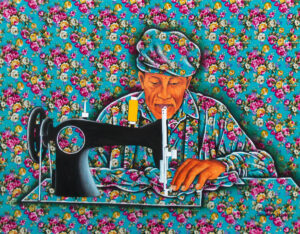 The garden of Gildásio - Gildásio Jardim relates a remarkable life story, reflecting the experience of a tiny rural community in paintings that magically blend with real life.
The garden of Gildásio - Gildásio Jardim relates a remarkable life story, reflecting the experience of a tiny rural community in paintings that magically blend with real life. One Island One Product? - Garland was recently invited to a forum in Ho Chi Minh City organised by Vietcraft about the One Village One Product movement. It has great potential to enhance our resilience and sustainability.
One Island One Product? - Garland was recently invited to a forum in Ho Chi Minh City organised by Vietcraft about the One Village One Product movement. It has great potential to enhance our resilience and sustainability. 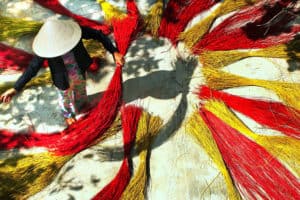 Garland in Vietnam - Join us as we explore the One Village One Product movement in Vietnam.
Garland in Vietnam - Join us as we explore the One Village One Product movement in Vietnam.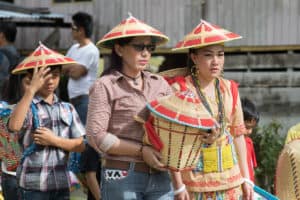 Bridewealth of the Dayak Lundayeh - Karen Macdonald with Paulus Kadok describe a marriage ceremony in a Dayak village of Kalimantan. With help from John Boyd McDonald's photos, they show how the adat rituals involving textile and fibres crafts remain a vivid part of their cultural life.
Bridewealth of the Dayak Lundayeh - Karen Macdonald with Paulus Kadok describe a marriage ceremony in a Dayak village of Kalimantan. With help from John Boyd McDonald's photos, they show how the adat rituals involving textile and fibres crafts remain a vivid part of their cultural life.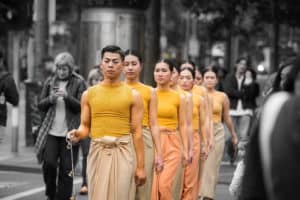 From Prao to Melbourne – Lanna culture in the world - Prao village This story is a true memory from my childhood in 1987. I grew up in the village called Prao, a small village in the middle of forest and mountain, located in the northern of Thailand. It takes about one and a half hour to drive to the north from Chiang Mai City. The […]
From Prao to Melbourne – Lanna culture in the world - Prao village This story is a true memory from my childhood in 1987. I grew up in the village called Prao, a small village in the middle of forest and mountain, located in the northern of Thailand. It takes about one and a half hour to drive to the north from Chiang Mai City. The […]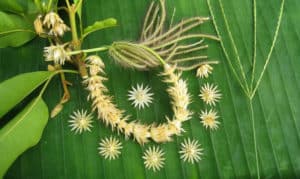 Where is your village? - While villages can take radically different form depending on their host country—from the Indonesian kampung set in a lush valley to a hamlet off the coast of New Zealand’s south island—they do share a common difference from the ubiquitous city. Most people who live in a village are likely to know each other’s name. Relations are not as dependent on financial transactions: there is often collective work towards a community space, such as a temple (in Britain, a place must have a church to be called a “village”). And often there is a set of traditions associated with that place, including myths, rituals and craft skills that make the most of materials at hand.
Where is your village? - While villages can take radically different form depending on their host country—from the Indonesian kampung set in a lush valley to a hamlet off the coast of New Zealand’s south island—they do share a common difference from the ubiquitous city. Most people who live in a village are likely to know each other’s name. Relations are not as dependent on financial transactions: there is often collective work towards a community space, such as a temple (in Britain, a place must have a church to be called a “village”). And often there is a set of traditions associated with that place, including myths, rituals and craft skills that make the most of materials at hand.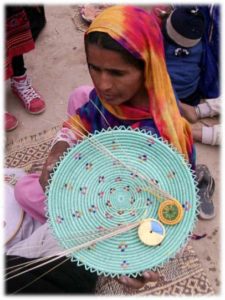 A labour of love: The Humnawa Project - Sahr Bashir travels 12 hours by bus to the Pakistani village deep in the Punjab region to "burst the urban bubble" and understand how design is not just about glamour but is also a matter of "real world" problem solving.
A labour of love: The Humnawa Project - Sahr Bashir travels 12 hours by bus to the Pakistani village deep in the Punjab region to "burst the urban bubble" and understand how design is not just about glamour but is also a matter of "real world" problem solving. Welcome to Kandangan, a modern craft village - Singgih Susilo Kartono introduces us to Kandangan, his village in Indonesia which has developed a way of "new craft" that aligns handmade production with modern management. He invites you to visit one day...
Welcome to Kandangan, a modern craft village - Singgih Susilo Kartono introduces us to Kandangan, his village in Indonesia which has developed a way of "new craft" that aligns handmade production with modern management. He invites you to visit one day...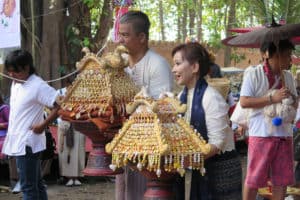 From gallery to temple: contemporary art for the Kra-tin ceremony - Watanya Siriwan offers her services as an artist for Kra-Tin, a ceremony to support a Buddhist temple by making clothes overnight, from harvesting cotton to assembling the garment. Her textile sculptures move between the gallery and the temple in a particularly Thai manner.
From gallery to temple: contemporary art for the Kra-tin ceremony - Watanya Siriwan offers her services as an artist for Kra-Tin, a ceremony to support a Buddhist temple by making clothes overnight, from harvesting cotton to assembling the garment. Her textile sculptures move between the gallery and the temple in a particularly Thai manner.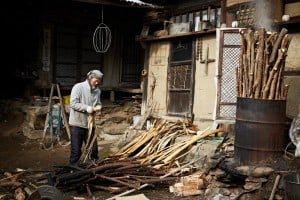 My Village Makes… - Your own village means that you’re not alone, that you know there’s something of you in the people and the plants and the soil, that even when you are not there it waits to welcome you. Cesare Pavese In mapping handmade creativity in the broader Asia-Pacific, it is not enough just to cover the major […]
My Village Makes… - Your own village means that you’re not alone, that you know there’s something of you in the people and the plants and the soil, that even when you are not there it waits to welcome you. Cesare Pavese In mapping handmade creativity in the broader Asia-Pacific, it is not enough just to cover the major […]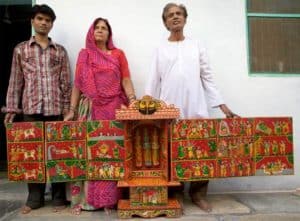 The kaavad: from devotion to decoration - For Ishan Khosla, ventures forth to revive the traditional storytelling device known as the kaavad. Does it still serve its original purpose as a form of religious worship? The kaavad that results from this quest tells the story of its own evolution from sacred to social.
The kaavad: from devotion to decoration - For Ishan Khosla, ventures forth to revive the traditional storytelling device known as the kaavad. Does it still serve its original purpose as a form of religious worship? The kaavad that results from this quest tells the story of its own evolution from sacred to social. 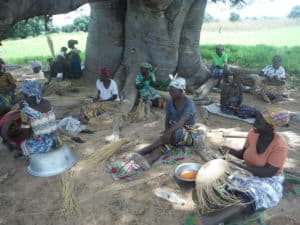 Paying the school fees: Bolga baskets in Ghana - NGO TradeAid is based in Bolgatanga, in the Upper East region of Ghana. Its goal is to end poverty in the northern regions. We hear from the weavers about the value of Bolga baskets in the lives of themselves and those they care for.
Paying the school fees: Bolga baskets in Ghana - NGO TradeAid is based in Bolgatanga, in the Upper East region of Ghana. Its goal is to end poverty in the northern regions. We hear from the weavers about the value of Bolga baskets in the lives of themselves and those they care for. 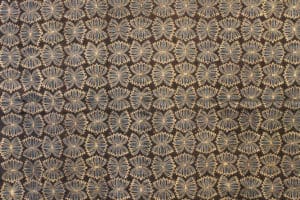 Sky’s the limit: The Cultural Textiles Rug Project - Liz Williamson describes an ongoing exchange with rug block printers in Gujarat who are commissioned to produce designs from Australia. The results show a wide-eyed view of India, such as kites in the skies over Ahmedabad.
Sky’s the limit: The Cultural Textiles Rug Project - Liz Williamson describes an ongoing exchange with rug block printers in Gujarat who are commissioned to produce designs from Australia. The results show a wide-eyed view of India, such as kites in the skies over Ahmedabad. The kediyun: A slow turn for fast fashion - Intrigued by the kediyun, a Rabari traditional upper garment, LOkesh Ghai apprentices himself to a traditional tailor. Along the way, he learns an important lesson for contemporary fashion.
The kediyun: A slow turn for fast fashion - Intrigued by the kediyun, a Rabari traditional upper garment, LOkesh Ghai apprentices himself to a traditional tailor. Along the way, he learns an important lesson for contemporary fashion.  Is Gandhi still alive? A journey to Surkhama - A young craft writer wonders where the spirit of Gandhi might be found in India today. Tanya Dutt hears of a remote village named Surkhama renowned for its handwoven rugs. Will Gandhi be there?
Is Gandhi still alive? A journey to Surkhama - A young craft writer wonders where the spirit of Gandhi might be found in India today. Tanya Dutt hears of a remote village named Surkhama renowned for its handwoven rugs. Will Gandhi be there?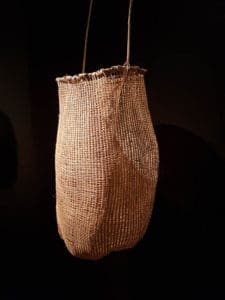 Fragile threads: Baskets reborn in north Queensland - In the first of a series of articles, Kevin Murray takes an overview of fibre practice in north Queensland. He finds a number of remarkable individuals who, despite lack of support, sustain unique fibre techniques to produce work of remarkable beauty and personal meaning.
Fragile threads: Baskets reborn in north Queensland - In the first of a series of articles, Kevin Murray takes an overview of fibre practice in north Queensland. He finds a number of remarkable individuals who, despite lack of support, sustain unique fibre techniques to produce work of remarkable beauty and personal meaning.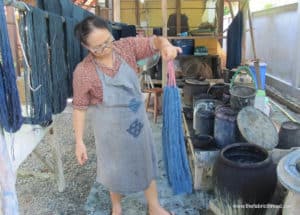 For the love of Lao – Studio Naenna - Ansie van der Walt profiles Patricia Cheesman, the founder of Studio Naenna, a remarkable business that now provides work for weavers from northeast Thailand and Laos. It began when she was charmed by Laotian hospitality.
For the love of Lao – Studio Naenna - Ansie van der Walt profiles Patricia Cheesman, the founder of Studio Naenna, a remarkable business that now provides work for weavers from northeast Thailand and Laos. It began when she was charmed by Laotian hospitality. In Ernabella, doors open for Aboriginal jewellery - An ambitious Australian project has recently emerged. The Indigenous Jewellery Project was initiated by Emily McCulloch Childs and to date has involved Melanie Katsalidis, Kate Rohde and Melinda Young. We learn from Emily about its origins, values, methods and future ambitions.
In Ernabella, doors open for Aboriginal jewellery - An ambitious Australian project has recently emerged. The Indigenous Jewellery Project was initiated by Emily McCulloch Childs and to date has involved Melanie Katsalidis, Kate Rohde and Melinda Young. We learn from Emily about its origins, values, methods and future ambitions.  Chilean horsehair jewellery across the Pacific - Crin (horsehair) jewellery is idiomatic to Chilean culture. Trinidad Estay has taken this technique to the other side of the Pacific where it develops a close relationship to its equine origins.
Chilean horsehair jewellery across the Pacific - Crin (horsehair) jewellery is idiomatic to Chilean culture. Trinidad Estay has taken this technique to the other side of the Pacific where it develops a close relationship to its equine origins.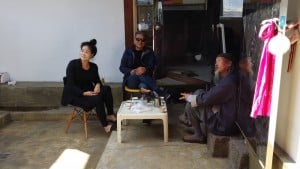 Yoon Jeong-won’s spiritual materialism - The artist Yoon Jeong-won uses storybook imagery to evoke the myriad of traditions in Korean culture. Besides major works for exhibition, she has a daily exercise of drawing on precious Korean paper made by Lee Jong Kuk (Mabeul), from a tree especially planted for her.
Yoon Jeong-won’s spiritual materialism - The artist Yoon Jeong-won uses storybook imagery to evoke the myriad of traditions in Korean culture. Besides major works for exhibition, she has a daily exercise of drawing on precious Korean paper made by Lee Jong Kuk (Mabeul), from a tree especially planted for her. Alpana: A Hindu craft that flourishes in a Muslim village - Mohammad Shahnewaz Khan describes the tradition of house decoration practiced by Hindus that is appreciated by the majority Muslim population.
Alpana: A Hindu craft that flourishes in a Muslim village - Mohammad Shahnewaz Khan describes the tradition of house decoration practiced by Hindus that is appreciated by the majority Muslim population. Cerdeira: An artist village of stone and wood - Tatiana Simões introduces Karine Locatelli, whose work flourished in this idyllic Portuguese village.
Cerdeira: An artist village of stone and wood - Tatiana Simões introduces Karine Locatelli, whose work flourished in this idyllic Portuguese village. 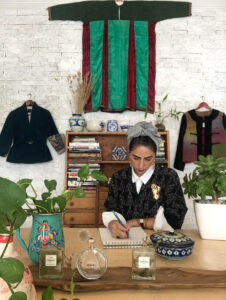 Sanaz Nataj ✿ Treasures from Qeshm and Khorashad - Atefe Mirsane uncovers the splendid couture of Sanaz Nataj, which draws on Iran's rich culture of village crafts.
Sanaz Nataj ✿ Treasures from Qeshm and Khorashad - Atefe Mirsane uncovers the splendid couture of Sanaz Nataj, which draws on Iran's rich culture of village crafts. The garden of Gildásio - Gildásio Jardim relates a remarkable life story, reflecting the experience of a tiny rural community in paintings that magically blend with real life.
The garden of Gildásio - Gildásio Jardim relates a remarkable life story, reflecting the experience of a tiny rural community in paintings that magically blend with real life.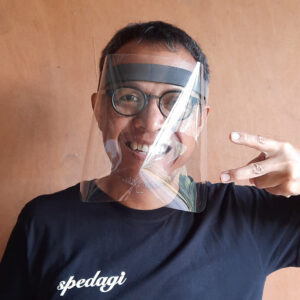 Kandangan village: A rich harvest of innovation for pandemic response - Alexandra Crosby catches up with Singgih Kartono in the village of Kandangan to find out how they are responding to the COVID-19 pandemic.
Kandangan village: A rich harvest of innovation for pandemic response - Alexandra Crosby catches up with Singgih Kartono in the village of Kandangan to find out how they are responding to the COVID-19 pandemic. Tying down art in my own public Idaho - Lily Martina Lee is inspired by the regional variations across the mid-West in the way folks secure their load.
Tying down art in my own public Idaho - Lily Martina Lee is inspired by the regional variations across the mid-West in the way folks secure their load. How an island makes its makers: The artisans of Gabriola - Phillip Vannini explains why he was drawn to film the artisans on an idyllic island in the Salish Sea.
How an island makes its makers: The artisans of Gabriola - Phillip Vannini explains why he was drawn to film the artisans on an idyllic island in the Salish Sea. One Island One Product? - Garland was recently invited to a forum in Ho Chi Minh City organised by Vietcraft about the One Village One Product movement. It has great potential to enhance our resilience and sustainability.
One Island One Product? - Garland was recently invited to a forum in Ho Chi Minh City organised by Vietcraft about the One Village One Product movement. It has great potential to enhance our resilience and sustainability.  Bridewealth of the Dayak Lundayeh - Karen Macdonald with Paulus Kadok describe a marriage ceremony in a Dayak village of Kalimantan. With help from John Boyd McDonald's photos, they show how the adat rituals involving textile and fibres crafts remain a vivid part of their cultural life.
Bridewealth of the Dayak Lundayeh - Karen Macdonald with Paulus Kadok describe a marriage ceremony in a Dayak village of Kalimantan. With help from John Boyd McDonald's photos, they show how the adat rituals involving textile and fibres crafts remain a vivid part of their cultural life. From Prao to Melbourne – Lanna culture in the world - Prao village This story is a true memory from my childhood in 1987. I grew up in the village called Prao, a small village in the middle of forest and mountain, located in the northern of Thailand. It takes about one and a half hour to drive to the north from Chiang Mai City. The […]
From Prao to Melbourne – Lanna culture in the world - Prao village This story is a true memory from my childhood in 1987. I grew up in the village called Prao, a small village in the middle of forest and mountain, located in the northern of Thailand. It takes about one and a half hour to drive to the north from Chiang Mai City. The […] Where is your village? - While villages can take radically different form depending on their host country—from the Indonesian kampung set in a lush valley to a hamlet off the coast of New Zealand’s south island—they do share a common difference from the ubiquitous city. Most people who live in a village are likely to know each other’s name. Relations are not as dependent on financial transactions: there is often collective work towards a community space, such as a temple (in Britain, a place must have a church to be called a “village”). And often there is a set of traditions associated with that place, including myths, rituals and craft skills that make the most of materials at hand.
Where is your village? - While villages can take radically different form depending on their host country—from the Indonesian kampung set in a lush valley to a hamlet off the coast of New Zealand’s south island—they do share a common difference from the ubiquitous city. Most people who live in a village are likely to know each other’s name. Relations are not as dependent on financial transactions: there is often collective work towards a community space, such as a temple (in Britain, a place must have a church to be called a “village”). And often there is a set of traditions associated with that place, including myths, rituals and craft skills that make the most of materials at hand.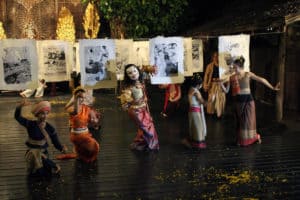 Hanging issues: Collaboration between photography and Lana paper making - A Kurdish photographer, doing a PhD at Melbourne's RMIT University, learns paper making in a northern Thai village in order to realise the emotions of the images gathered from the conflict in the Middle East. Rushdi Anwar shares the thinking behind this unique artistic alchemy.
Hanging issues: Collaboration between photography and Lana paper making - A Kurdish photographer, doing a PhD at Melbourne's RMIT University, learns paper making in a northern Thai village in order to realise the emotions of the images gathered from the conflict in the Middle East. Rushdi Anwar shares the thinking behind this unique artistic alchemy. Creative currencies in the cupboard: Cecile Williams in Denmark - Kevin Murray travels to the village of Denmark on the south-west coast of Australia to witness the world of Cecile Williams, a fibre artist whose investment in the material currencies of everyday life bears fruit in an amazingly vibrant community.
Creative currencies in the cupboard: Cecile Williams in Denmark - Kevin Murray travels to the village of Denmark on the south-west coast of Australia to witness the world of Cecile Williams, a fibre artist whose investment in the material currencies of everyday life bears fruit in an amazingly vibrant community.  A labour of love: The Humnawa Project - Sahr Bashir travels 12 hours by bus to the Pakistani village deep in the Punjab region to "burst the urban bubble" and understand how design is not just about glamour but is also a matter of "real world" problem solving.
A labour of love: The Humnawa Project - Sahr Bashir travels 12 hours by bus to the Pakistani village deep in the Punjab region to "burst the urban bubble" and understand how design is not just about glamour but is also a matter of "real world" problem solving.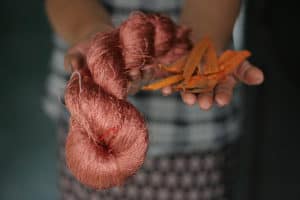 Sharing silent conversations through craft with Samorn Sanixay - Harriet Watts listens in to the silent conversation of Samorn Sanixay, who brings simple beauty of Laotian textiles to Australia, along with a basket of fresh garden produce..
Sharing silent conversations through craft with Samorn Sanixay - Harriet Watts listens in to the silent conversation of Samorn Sanixay, who brings simple beauty of Laotian textiles to Australia, along with a basket of fresh garden produce.. Welcome to Kandangan, a modern craft village - Singgih Susilo Kartono introduces us to Kandangan, his village in Indonesia which has developed a way of "new craft" that aligns handmade production with modern management. He invites you to visit one day...
Welcome to Kandangan, a modern craft village - Singgih Susilo Kartono introduces us to Kandangan, his village in Indonesia which has developed a way of "new craft" that aligns handmade production with modern management. He invites you to visit one day... Quest for the lost bronze casters: A journey to Ban Pa Ao - A dinner party conversation sets Rudee Tancharoen on a quest to find the lost casters of northern Thailand. She discovers an ancient village who welcomed her visit.
Quest for the lost bronze casters: A journey to Ban Pa Ao - A dinner party conversation sets Rudee Tancharoen on a quest to find the lost casters of northern Thailand. She discovers an ancient village who welcomed her visit.  From gallery to temple: contemporary art for the Kra-tin ceremony - Watanya Siriwan offers her services as an artist for Kra-Tin, a ceremony to support a Buddhist temple by making clothes overnight, from harvesting cotton to assembling the garment. Her textile sculptures move between the gallery and the temple in a particularly Thai manner.
From gallery to temple: contemporary art for the Kra-tin ceremony - Watanya Siriwan offers her services as an artist for Kra-Tin, a ceremony to support a Buddhist temple by making clothes overnight, from harvesting cotton to assembling the garment. Her textile sculptures move between the gallery and the temple in a particularly Thai manner. My Village Makes… - Your own village means that you’re not alone, that you know there’s something of you in the people and the plants and the soil, that even when you are not there it waits to welcome you. Cesare Pavese In mapping handmade creativity in the broader Asia-Pacific, it is not enough just to cover the major […]
My Village Makes… - Your own village means that you’re not alone, that you know there’s something of you in the people and the plants and the soil, that even when you are not there it waits to welcome you. Cesare Pavese In mapping handmade creativity in the broader Asia-Pacific, it is not enough just to cover the major […] The kaavad: from devotion to decoration - For Ishan Khosla, ventures forth to revive the traditional storytelling device known as the kaavad. Does it still serve its original purpose as a form of religious worship? The kaavad that results from this quest tells the story of its own evolution from sacred to social.
The kaavad: from devotion to decoration - For Ishan Khosla, ventures forth to revive the traditional storytelling device known as the kaavad. Does it still serve its original purpose as a form of religious worship? The kaavad that results from this quest tells the story of its own evolution from sacred to social. 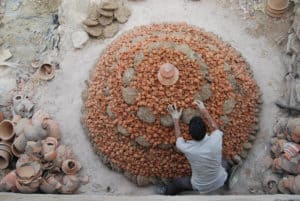 Quarterly essay – The world in a chai cup: Sandra Bowkett and a village of Indian potters - In an old cardboard box on the concrete floor of Sandra Bowkett’s studio there is a huddle of raw-looking chai cups. They are Indian by design and were made by an Indian potter. What are they doing here in rural Victoria? Are they out of place? There are certainly no chai-wallahs (Indian tea-sellers) to be […]
Quarterly essay – The world in a chai cup: Sandra Bowkett and a village of Indian potters - In an old cardboard box on the concrete floor of Sandra Bowkett’s studio there is a huddle of raw-looking chai cups. They are Indian by design and were made by an Indian potter. What are they doing here in rural Victoria? Are they out of place? There are certainly no chai-wallahs (Indian tea-sellers) to be […] Paying the school fees: Bolga baskets in Ghana - NGO TradeAid is based in Bolgatanga, in the Upper East region of Ghana. Its goal is to end poverty in the northern regions. We hear from the weavers about the value of Bolga baskets in the lives of themselves and those they care for.
Paying the school fees: Bolga baskets in Ghana - NGO TradeAid is based in Bolgatanga, in the Upper East region of Ghana. Its goal is to end poverty in the northern regions. We hear from the weavers about the value of Bolga baskets in the lives of themselves and those they care for.  Sky’s the limit: The Cultural Textiles Rug Project - Liz Williamson describes an ongoing exchange with rug block printers in Gujarat who are commissioned to produce designs from Australia. The results show a wide-eyed view of India, such as kites in the skies over Ahmedabad.
Sky’s the limit: The Cultural Textiles Rug Project - Liz Williamson describes an ongoing exchange with rug block printers in Gujarat who are commissioned to produce designs from Australia. The results show a wide-eyed view of India, such as kites in the skies over Ahmedabad. The kediyun: A slow turn for fast fashion - Intrigued by the kediyun, a Rabari traditional upper garment, LOkesh Ghai apprentices himself to a traditional tailor. Along the way, he learns an important lesson for contemporary fashion.
The kediyun: A slow turn for fast fashion - Intrigued by the kediyun, a Rabari traditional upper garment, LOkesh Ghai apprentices himself to a traditional tailor. Along the way, he learns an important lesson for contemporary fashion.  Is Gandhi still alive? A journey to Surkhama - A young craft writer wonders where the spirit of Gandhi might be found in India today. Tanya Dutt hears of a remote village named Surkhama renowned for its handwoven rugs. Will Gandhi be there?
Is Gandhi still alive? A journey to Surkhama - A young craft writer wonders where the spirit of Gandhi might be found in India today. Tanya Dutt hears of a remote village named Surkhama renowned for its handwoven rugs. Will Gandhi be there? Fragile threads: Baskets reborn in north Queensland - In the first of a series of articles, Kevin Murray takes an overview of fibre practice in north Queensland. He finds a number of remarkable individuals who, despite lack of support, sustain unique fibre techniques to produce work of remarkable beauty and personal meaning.
Fragile threads: Baskets reborn in north Queensland - In the first of a series of articles, Kevin Murray takes an overview of fibre practice in north Queensland. He finds a number of remarkable individuals who, despite lack of support, sustain unique fibre techniques to produce work of remarkable beauty and personal meaning. For the love of Lao – Studio Naenna - Ansie van der Walt profiles Patricia Cheesman, the founder of Studio Naenna, a remarkable business that now provides work for weavers from northeast Thailand and Laos. It began when she was charmed by Laotian hospitality.
For the love of Lao – Studio Naenna - Ansie van der Walt profiles Patricia Cheesman, the founder of Studio Naenna, a remarkable business that now provides work for weavers from northeast Thailand and Laos. It began when she was charmed by Laotian hospitality. The wonder of rattan in Vietnam - Sarah Thomas' new life in Vietnam has produced an amazing range of rattan furniture, skillfully made by local weavers.
The wonder of rattan in Vietnam - Sarah Thomas' new life in Vietnam has produced an amazing range of rattan furniture, skillfully made by local weavers.  In Ernabella, doors open for Aboriginal jewellery - An ambitious Australian project has recently emerged. The Indigenous Jewellery Project was initiated by Emily McCulloch Childs and to date has involved Melanie Katsalidis, Kate Rohde and Melinda Young. We learn from Emily about its origins, values, methods and future ambitions.
In Ernabella, doors open for Aboriginal jewellery - An ambitious Australian project has recently emerged. The Indigenous Jewellery Project was initiated by Emily McCulloch Childs and to date has involved Melanie Katsalidis, Kate Rohde and Melinda Young. We learn from Emily about its origins, values, methods and future ambitions.  Chilean horsehair jewellery across the Pacific - Crin (horsehair) jewellery is idiomatic to Chilean culture. Trinidad Estay has taken this technique to the other side of the Pacific where it develops a close relationship to its equine origins.
Chilean horsehair jewellery across the Pacific - Crin (horsehair) jewellery is idiomatic to Chilean culture. Trinidad Estay has taken this technique to the other side of the Pacific where it develops a close relationship to its equine origins.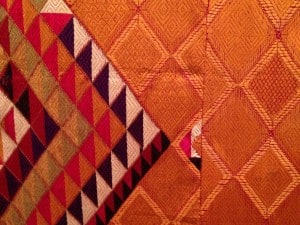 Quarterly essay – Reclaiming the Lost Embroidered Garden - Unlike block printing, weaving and other textile arts, embroidery work such as Phulkari is heavily invested with the passion and presence of the person handling the needle and thread.
Quarterly essay – Reclaiming the Lost Embroidered Garden - Unlike block printing, weaving and other textile arts, embroidery work such as Phulkari is heavily invested with the passion and presence of the person handling the needle and thread. Yoon Jeong-won’s spiritual materialism - The artist Yoon Jeong-won uses storybook imagery to evoke the myriad of traditions in Korean culture. Besides major works for exhibition, she has a daily exercise of drawing on precious Korean paper made by Lee Jong Kuk (Mabeul), from a tree especially planted for her.
Yoon Jeong-won’s spiritual materialism - The artist Yoon Jeong-won uses storybook imagery to evoke the myriad of traditions in Korean culture. Besides major works for exhibition, she has a daily exercise of drawing on precious Korean paper made by Lee Jong Kuk (Mabeul), from a tree especially planted for her.
